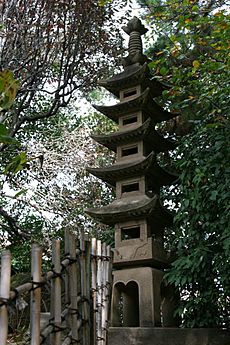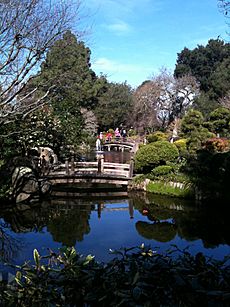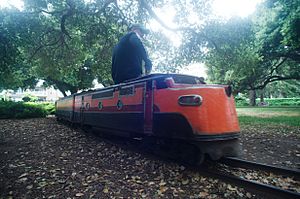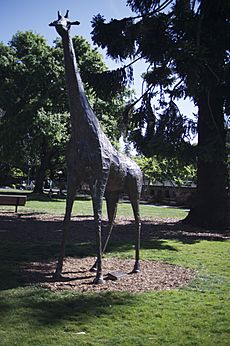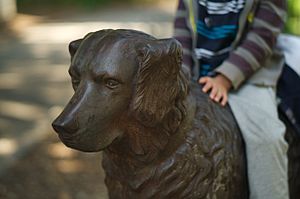Central Park (San Mateo) facts for kids
Quick facts for kids Central Park & Recreation Center |
|
|---|---|
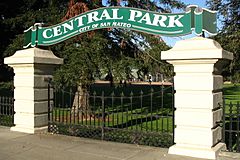
Entrance sign for Central Park
|
|
| Lua error in Module:Location_map at line 420: attempt to index field 'wikibase' (a nil value). | |
| Type | Urban park |
| Location | San Mateo, California |
| Area | 16.5 acres (7 ha) |
| Open | 1922 |
| Parking | street, garage |
| Public transit access |
|
Central Park is a super fun place in San Mateo, California! It's the very first public park in the city. This awesome urban park is about 16.5 acres big, which is like 12 football fields! It's surrounded by busy streets like El Camino Real and 5th Avenue.
The park opened way back in 1922. People voted to buy the land from Charles B. Polhemus to create this amazing space. Today, Central Park has so many cool things to do. You can find a baseball field, tennis courts, and even a special Japanese tea garden. There's also a playground, a miniature train, and a beautiful rose garden. It's a great spot for everyone to enjoy!
Awesome Things to See and Do
Central Park is packed with cool features. Let's explore some of the highlights!
Recreation Center
The park has a recreation center that helps senior citizens. It offers many activities for them during the week. There are also ceramics classes and a studio in a building next to the tennis courts. It's a busy place for older adults in San Mateo County.
Fitzgerald Field: Play Ball!
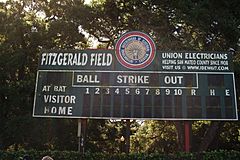
Scoreboard at Fitzgerald Field
|
|
| Full name | Justin "Fitz" Fitzgerald Memorial Field |
|---|---|
| Owner | City of San Mateo |
| Type | Stadium |
| Genre(s) | Baseball |
| Seating type | bleachers |
| Capacity | 1,500 |
| Field size |
|
| Surface | grass |
| Scoreboard | Electronic |
| Construction | |
| Built | 1922 |
| Tenants | |
| San Mateo Blues (1924–1941; 1948–1978) |
|
One of the oldest parts of Central Park is the baseball field. It was built when the park first opened in 1922. A local team called the San Mateo Blues played here for many years. They were a semi-professional team and won championships in the 1920s and 30s.
The field is named after Justin "Fitz" Fitzgerald. He managed the Blues team for a long time. There's even a plaque on the grandstand to remember him. A famous baseball player, Barry Bonds, reportedly hit home runs from this field across El Camino Real when he played high school baseball!
Tennis Courts
Central Park has six tennis courts where you can play day or night. They are located on the roof of a parking garage. It's a great place to practice your serve or play a match with friends.
Japanese Tea Garden
Step into the peaceful Japanese Tea Garden! It was designed in 1966 and is full of beautiful plants. You'll see cherry trees, Japanese maples, and tiny bonsai trees. San Mateo has a special friendship with the city of Toyonaka, Japan. Toyonaka has given the garden some cool sculptures.
Look for the five-level stone pagoda statue, which arrived in 1963. There's also a small shinden shrine. The garden has a traditional gazebo and a teahouse. It's a perfect spot to relax and enjoy nature.
Children's Playground and Miniature Train
The children's playground is a fantastic place for younger kids. It has a big play structure and climbing equipment in a sandbox. Right nearby, there's a miniature railway that runs in a loop!
The miniature train has been giving rides since 1948. It's a special Arrow Streamliner locomotive that can carry up to 10 children. A ride costs just $2! The train is painted like the old Southern Pacific "Daylight" trains. Sometimes, the train operator even opens a snack bar at the baseball field.
San Mateo Arboretum and Rose Garden
The park also has a lovely rose garden with a gazebo. It's a popular spot for taking photos and even for weddings! The San Mateo Arboretum Society helps take care of the plants in the park. They also restored an old pumphouse, which is now their meeting place. Volunteers from the society plant and maintain the beautiful rose garden.
Sculptures and Old Buildings
Keep an eye out for some cool sculptures! There's a life-size giraffe statue named Leon. It was made from copper plates by Albert Guibara in 1978. You can find Leon on the park's northeast lawn.
There's also an old Italian cast-iron statue of a dog. Kids love to see it! This statue has been in the park since the early days. You can also see an old wrought-iron fence along El Camino Real. The Kohl pumphouse is the only building left from when the Kohl family owned the land.
Fun Events All Year Long
Central Park hosts many exciting events throughout the year!
Baseball Games with Toyonaka
Since 1979, young baseball players from San Mateo and its sister city, Toyonaka, Japan, have played a special series of games. They take turns hosting the event every two years. When San Mateo hosts, the final game is played right here at Fitzgerald Field!
Central Park Music Series
During the summer, Central Park comes alive with music! The Central Park Music Series offers free concerts on Thursday nights. Local bands from the Bay Area play live music. In 2024, there were eight concerts, and there were also eight planned for 2025. The only year they skipped was 2020, because of the COVID-19 pandemic.
Eggstravaganza and Other Holidays
Every spring, the City of San Mateo holds its Eggstravaganza egg hunt and parade at Central Park. It's a super fun event for families! Other holidays and events are celebrated here too, like the San Mateo Bacon & Brew Festival in October and the Holiday Floral Art Show in December. You can even go ice skating at "San Mateo on Ice" from November to January!
Park History
The land that is now Central Park has a long history. In 1854, a man named Charles B. Polhemus bought the land. He built a big mansion there. Later, in 1880, William Kohl bought the estate. He hired famous landscapers to design the grounds with many trees and a long stone and iron fence. Many of Kohl's trees and the fence are still in the park today!
The City of San Mateo bought most of the land in 1922. This is when it officially became the first public park in the city. The baseball field was one of the first things built. An additional small piece of land was added in 1926.
For a few years, from 1923 to 1927, San Mateo Junior College used the old Kohl mansion on the park grounds. But the mansion was taken down in 1928. Many of the park's current features, like the playground, recreation center, and tennis courts, were added later when Stanley Pitcher was in charge of the parks.


